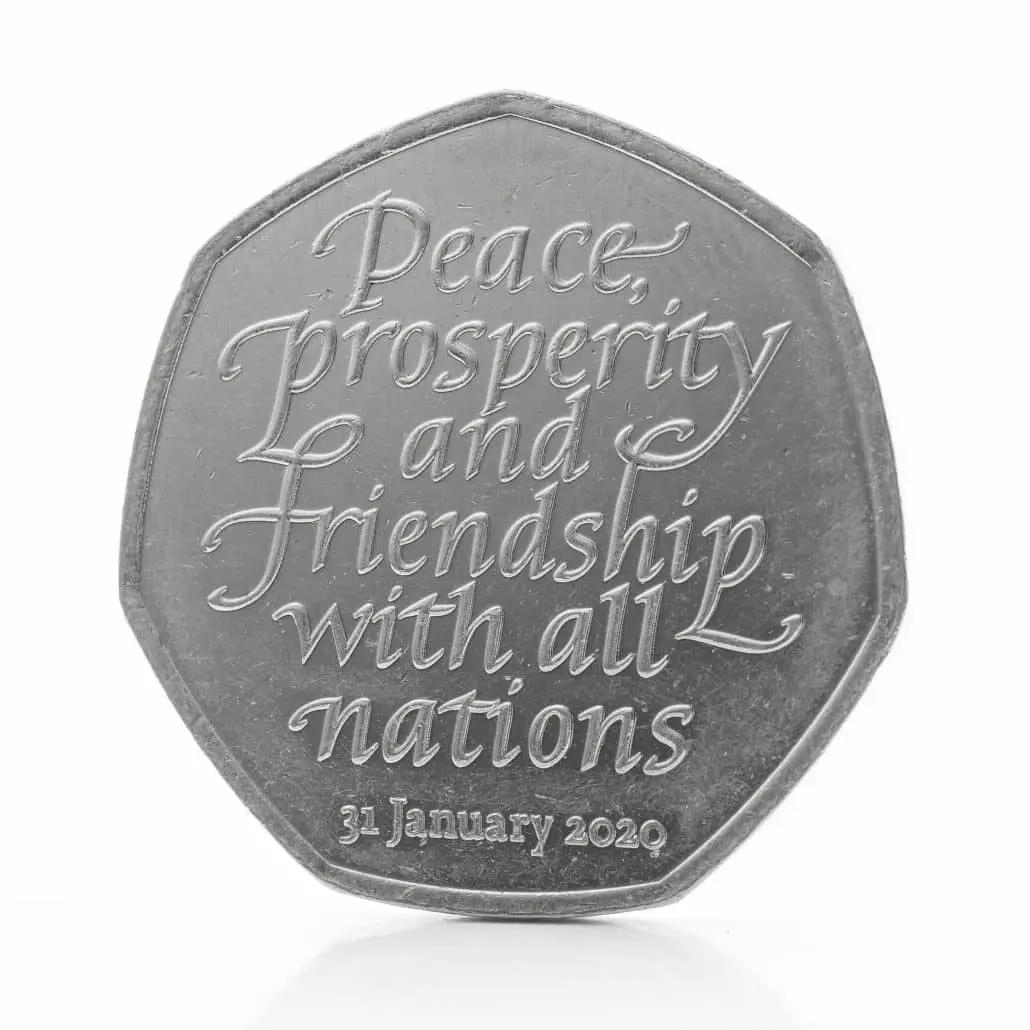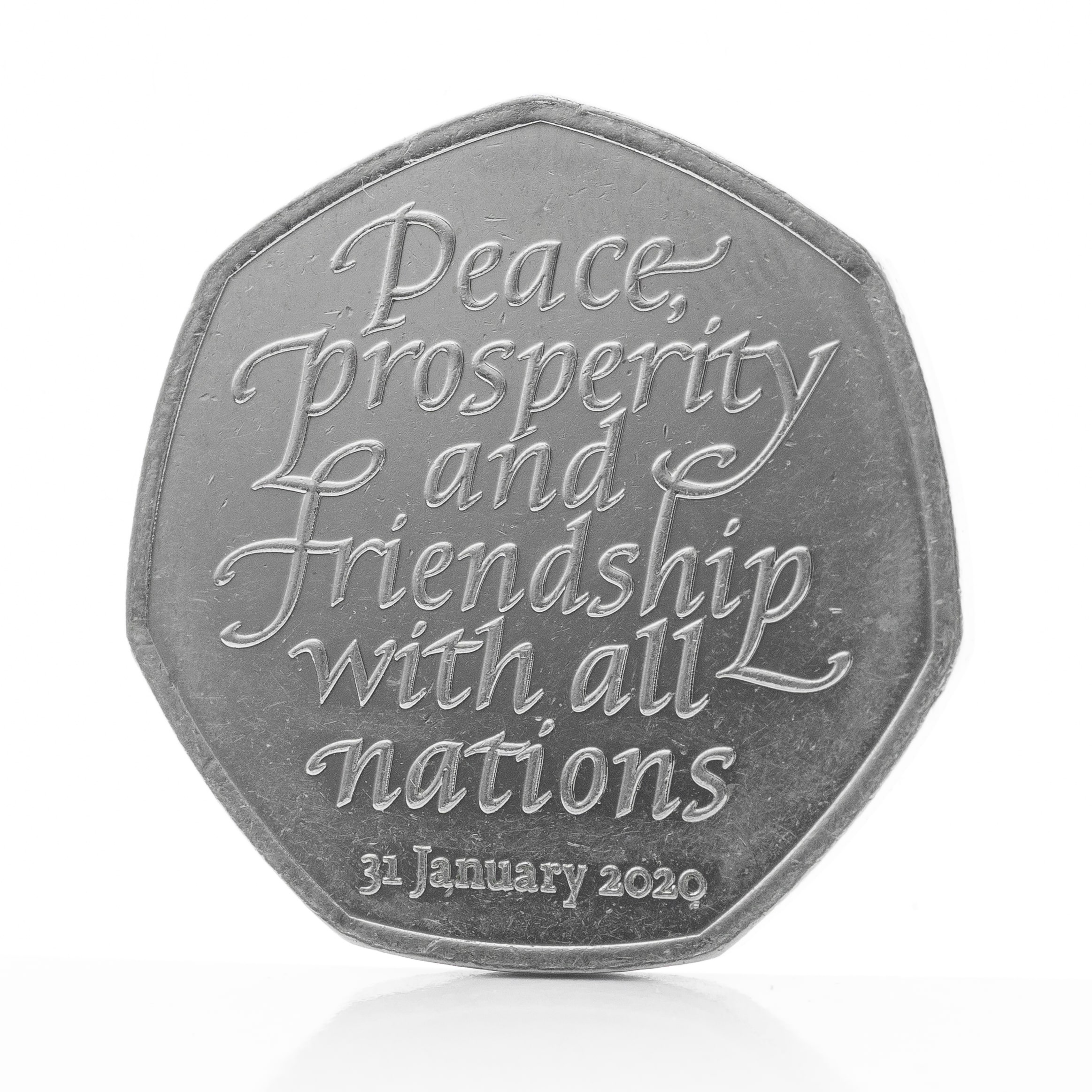The Withdrawal from the European Union 50p, better known as the Brexit 50p, has caused quite the commotion – but is it actually worth anything to coin collectors?
We’ve taken a look at eBay, and you can typically find the coin in circulated condition selling for an average of £1.67 not including postage and packaging.
As a relatively new coin released in 2020, there is a good chance you will have come across this coin in your change over the past year.
Let’s take a look at the mintage and design of the coin to get a better idea of why the Brexit 50p is sought after.
How many Brexit 50p coins were made?
The coin was released into circulation on 31st January 2020, with an initial minting of 3 million, and is the only official UK coin to commemorate the occasion. A further 1.5 million were released soon after, rising to 7 million by September 2020.
In December of 2020, it was estimated that the mintage of the Brexit 50p was to be around 10 million, meaning the Brexit 50p is one of only 3 coins to receive over 10 million mintage since 2015.
The official mintage has since been released as 10,001,000 in September of 2021, meaning the previous estimates were very accurate. This also means that the coin is not very rare when compared to other 50p coins, like the infamous Kew Gardens 50p which has a mintage of just 210,000.
The coin was initially scheduled for release on March 31st 2019. A second batch was manufactured when Brexit was further delayed until October 31, 2019. The minting was then paused to reflect the political uncertainty of the time. Most of these first two batches have been recalled and melted down into other coinage, however, industry sources claim that 5 coins from the March and October run are still in existence.
Gold and silver versions of the coin were announced for collectors in December 2019.
The Brexit 50p is not the only coin minted concerning the UK’s relationship with the European Union and is by no means the rarest.
In 1973, the UK released the European Economic Community 50p, to commemorate the UK’s entry into the EEA, with a mintage of 89.7 million (third highest behind the 1969 Brittania 50p and the 2019 Royal Shield 50p). The 1992 Single Market 50p is by far the rarest of the remaining EU commemorative coins, with only 109,000 ever made.
These 50p coins are, of course, in the form of the old-style 50p shape which was changed in 1997 to the 50p that we are all familiar with today; meaning you are very unlikely to find them in your change.
The Design of the Brexit 50p coin
The coin is 27.30mm in diameter and weighs 8g. The standard circulation minting is made of cupro-nickel
The obverse features a right-facing portrait of Elizabeth II with the inscription ‘50 PENCE.2020.ELIZABETH.II.D.G.REG.F.D’.
The reverse features the embossed quote ‘Peace, prosperity and friendship with all nations’ in a flourished, cursive script that takes up approximately 80% of the coin face. The quote is a paraphrase of Thomas Jefferson’s inaugural address as the third President of the United States (1801-1809). Jefferson’s actual words were ‘peace, commerce, and honest friendship with all nations: entangling alliances with none’, as he laid out his administration’s priorities.

The coin’s version of Jefferson’s message drew criticism from the literary community, who accused it of being grammatically incorrect and questioned the need to put an American statesman’s words on a British coin designed to commemorate its relationship with Europe. Author Philip Pullman called for an Oxford comma between the words ‘prosperity’ and ‘and’ on the coin.
This issue became somewhat of a national debate, with defenders of the Chancellor’s grammar squaring off against those who felt that the Government had got it wrong, and the coin should either be redesigned or boycotted.
As with most things Brexit however, these opinions framed themselves in the whole debate as to whether or not Britain should have left the EU in the first place. The Chancellor dismissed them and the coin continued to be minted without any alterations.
Also criticised was the typeface used to convey Jefferson’s words. Some compared it to a cheap version of the Clinton Cards logo, a popular British greeting card retailer, or highlighted similarities with 1990s word processor fonts.
The date ‘31 January 2020’ is inscribed beneath the quote in a smaller font, representing the date that the UK officially left the EU. This date replaces earlier versions that displayed ‘31 October 2019’.
Why was the Brexit 50p coin made and what does it commemorate?
The coin was made to commemorate Britain leaving the EU, on 31 January 2020.
The UK has a tradition of minting coins to commemorate momentous occasions in British history (D-Day etc.) and Brexit is no different. Three and a half years after the Leave campaign won the EU referendum, Britain put an end to its 47-year relationship with first the EEC (which it joined in 1973) then later the EU.
The coin was ordered to be produced before the original leaving date of 31 October 3019 by the then Chancellor and Master of the Mint, Sajid Javid MP. The Chancellor said at the time: “Leaving the European Union is a turning point in our history and this coin marks the beginning of this new chapter.”
It is hard to imagine a British coin – collector’s item or otherwise – that has caused so much controversy or stimulated as much national debate. Brexit was, and still is, a polarising political issue, causing some people to create alternate versions of the coin bearing Remain campaign slogans, and even going so far as to start campaigns to bring the coin out of circulation.
Prominent political figures at the time, such as Alistair Campbell, gave high-profile interviews that called on shopkeepers not to distribute the coins from their cash registers, and instead return the coins to the bank.
Other individuals lobbied for the coins to be gathered up and donated to several Remain campaigns such as the official ‘Rejoin’ campaign, or the EU citizens’ charity ‘the3million’, which lobbied for greater representation of EU citizens’ rights, post-Brexit.
Where can you buy the coin?
As we’ve already mentioned, eBay is probably the best bet if you’re looking to pick up a standard circulated version, for which you can expect to pay just over a pound, not including shipping.
The Royal Mint is the best place to buy the coin otherwise. They have brilliant uncirculated examples, coin sets featuring the coin and silver/gold proof examples in limited edition.
